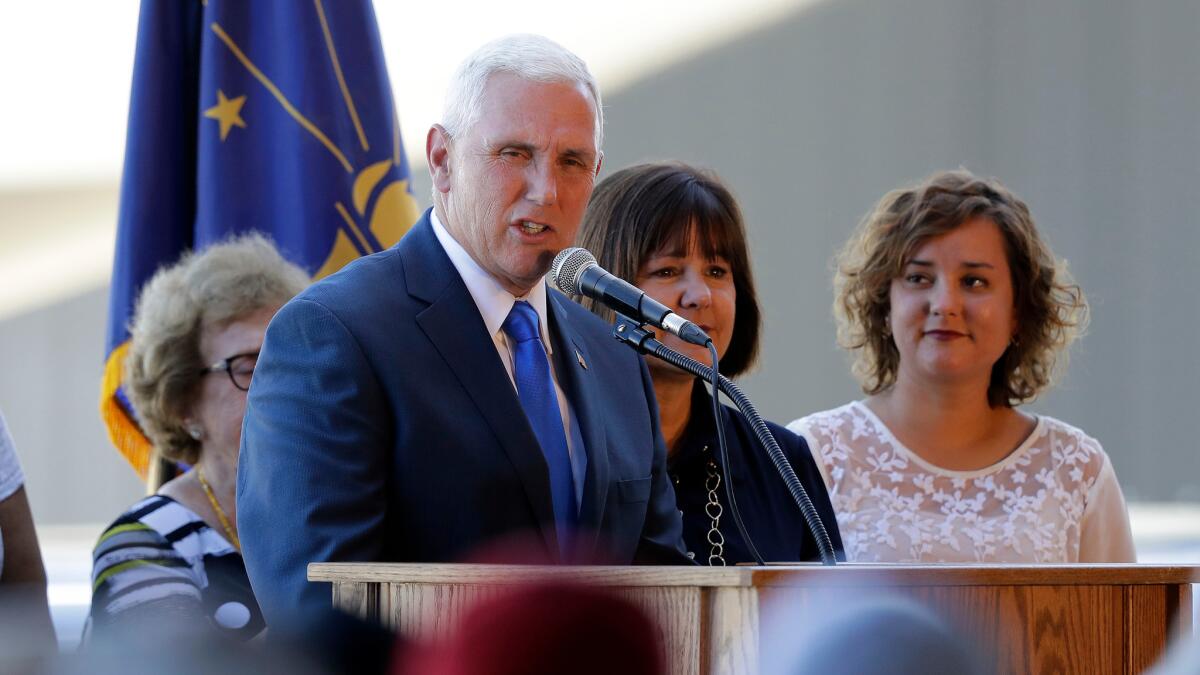Donald Trump’s running mate once peddled conspiracy theories about anthrax and Saddam Hussein

WASHINGTON — Republican presidential candidate Donald Trump’s running mate stirred public concern after the 2001 anthrax letter attacks by asserting — without any scientific evidence — that the material had been “genetically modified” to make it more deadly.
The statement by then-Rep. Mike Pence, now governor of Indiana, suggested that a foreign source — likely Saddam Hussein’s Iraq — was responsible for the letter attacks, which killed five people, disrupted mail delivery and temporarily shut down congressional office buildings.
The FBI ultimately concluded that an Army anthrax scientist, Bruce E. Ivins, carried out the attacks. Ivins, based at Ft. Detrick, Md., committed suicide in July 2008 after his lawyers informed him that he would be indicted.
Pence made his claims in June 2002, nine months after the first of two batches of anthrax-laced letters were put in the mail in Princeton, N.J.
“Why has the FBI apparently concluded that the source of these anthrax attacks was domestic when there is significant evidence to suggest an international source for these materials?” Pence wrote in a public letter to Atty Gen. John D. Ashcroft.
One of the contaminated letters, addressed to then-Senate Majority Leader Tom Daschle (D-S.D.), spilled dry-powder anthrax when an intern opened it on the sixth floor of the Hart Senate Office Building in October 2001. The building was shuttered for decontamination, and trace levels of anthrax were later detected elsewhere on Capitol Hill.
“The material found in my office and in others on Capitol Hill was finely milled weapons-grade anthrax that had been genetically modified to increase its virulence,” Pence wrote.
Pence’s claim of genetically altered anthrax was unfounded, according to scientists who analyzed the material recovered from the letters.
“That’s just wrong. That’s simply wrong — and we knew at the time that it was wrong,” said Johns Hopkins University scientist Steven L. Salzberg, who was part of the first team of scientists to analyze the material for the government.
As for Pence’s assertion that the pathogen was “weapons grade,” there is no set standard for what constitutes weapons-grade anthrax.
Asked for comment, a spokesman for Pence said the governor’s aides would look into the issue. A spokeswoman for Trump did not respond to a request for comment.
The first indication that the mailed anthrax was not genetically modified came in early October 2001, when Ivins’ colleagues at Ft. Detrick determined that the infectious agent was treatable with all standard antibiotics.
Pence himself indicated as much during a news conference outside the Capitol on Oct. 27, 2001. He announced that he, his family and his staff would take the antibiotic doxycycline as a precaution.
C-SPAN footage shows that Pence introduced Dr. Greg Martin, a Navy infectious disease specialist, who said the mailed anthrax “has been very sensitive to all of the typical antibiotics that can be used.”
“So we feel quite confident in the medications that we have that we will see no cases of anthrax out of the congressman’s office,” Martin said.
By early 2002, the work done by Salzberg and his colleagues provided definitive proof that the material had not been genetically altered, and the FBI shared this information with members of Congress and the Bush administration, current and former officials said.
“We had the data from the genome back in January, February [2002],” said Paul S. Keim, a Northern Arizona University geneticist who collaborated with Salzberg and became the leading outside scientist assisting the investigation. “So we knew there were no genetic engineering things going on back then.”
Asked about Pence’s claims, Keim said: “He either was getting grossly bad information from somebody, or he certainly couldn’t discern good information from bad information.”
In his June 2002 letter to Ashcroft, Pence also said the anthrax spores had been “coated with a chemical,” an assertion that, by March of that year, had been disproven by scientists at the Sandia National Laboratories in New Mexico.
The anthrax attacks, coming soon after the suicide hijackings of Sept. 11, 2001, spurred fears that the nation was facing a second wave of terrorism – fears heightened by the sender’s use of phrases such as “Allah is Great.”
The deadly mailings figured in the Bush administration’s case for invading Iraq. Then-Secretary of State Colin Powell cited the anthrax attacks when he addressed the United Nations on Feb. 5, 2003, to seek international support for military action against Iraq.
Powell held a vial of white powder and said that a similarly small, teaspoon-size quantity of anthrax in one of the 2001 letters had caused havoc in Washington and killed two postal workers. Powell then suggested that Iraq had stockpiled enough anthrax “to fill tens upon tens upon tens of thousands of teaspoons.”
In his letter to Ashcroft, Pence said the death toll from the mailings “suggests that professionals in an organized, large-scale research facility” were to blame.
Pence went on to allege — consistent with other early proponents of the Iraq war — that there was a connection between Hussein’s regime and Al Qaeda.
Dwight E. Adams, a biologist who headed the FBI crime laboratory from 2001 to 2006, said that Pence’s “leap of genetic modification at that early stage baffles me.”
“He was out in the forefront, hyping this without facts,” said Adams, now director of the Forensic Science Institute at Central Oklahoma University.
Adams and others noted that, as of June 2002, the FBI was continuing to collect samples of anthrax worldwide. Although at that point the mailings appeared to the bureau to have originated in the U.S., investigators had not yet excluded foreign involvement, as Pence’s letter suggested.
Salzberg, whose role in the investigation began when he was at the Institute for Genomic Research in Rockville, Md., said: “I don’t know where he was getting his information. If he made those statements without talking to someone with direct knowledge of the molecular biology and genetics … then that was irresponsible.”
Scott Decker, a geneticist and retired FBI agent who managed scientific aspects of the case, said that genetically engineered anthrax “was the first thing that we worried about, because of antibiotic resistance.”
Asked if any evidence emerged to support Pence’s assertion, Decker said: “None whatsoever.”
Twitter: @dwillmannews
ALSO
Trump chooses Mike Pence as his running mate, a pick that could soothe nervous Republicans
Donald Trump’s new campaign logo was mocked so much that it got quickly replaced
UPDATES:
7 p.m.: This article was updated with a comment from Gov. Mike Spence’s spokesman.
This article was originally published at 6:15 p.m.
More to Read
Get the L.A. Times Politics newsletter
Deeply reported insights into legislation, politics and policy from Sacramento, Washington and beyond. In your inbox three times per week.
You may occasionally receive promotional content from the Los Angeles Times.











